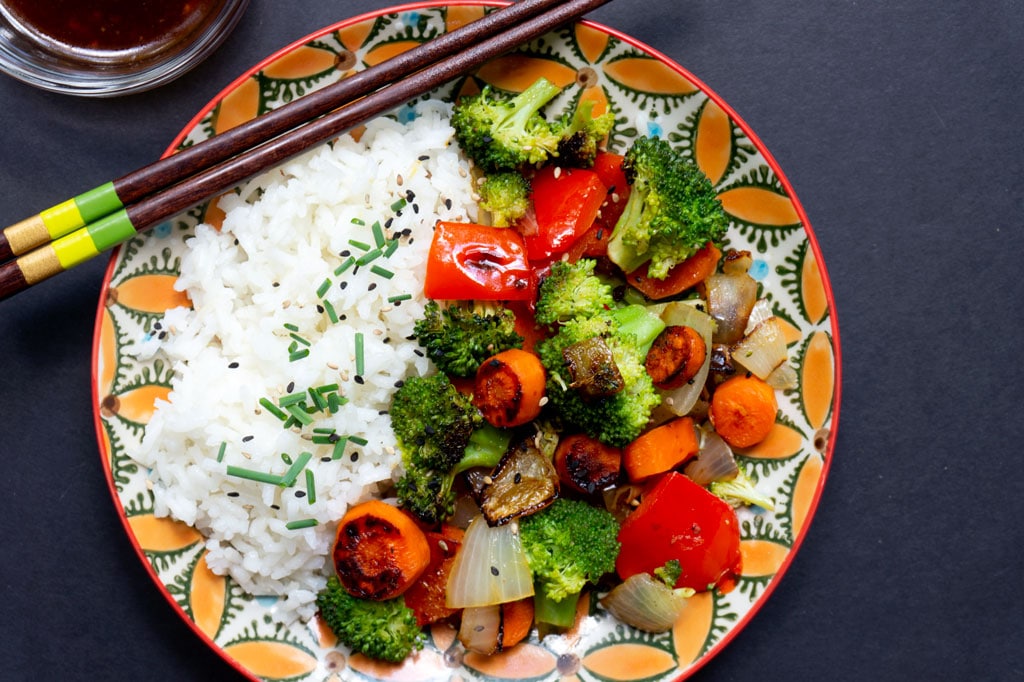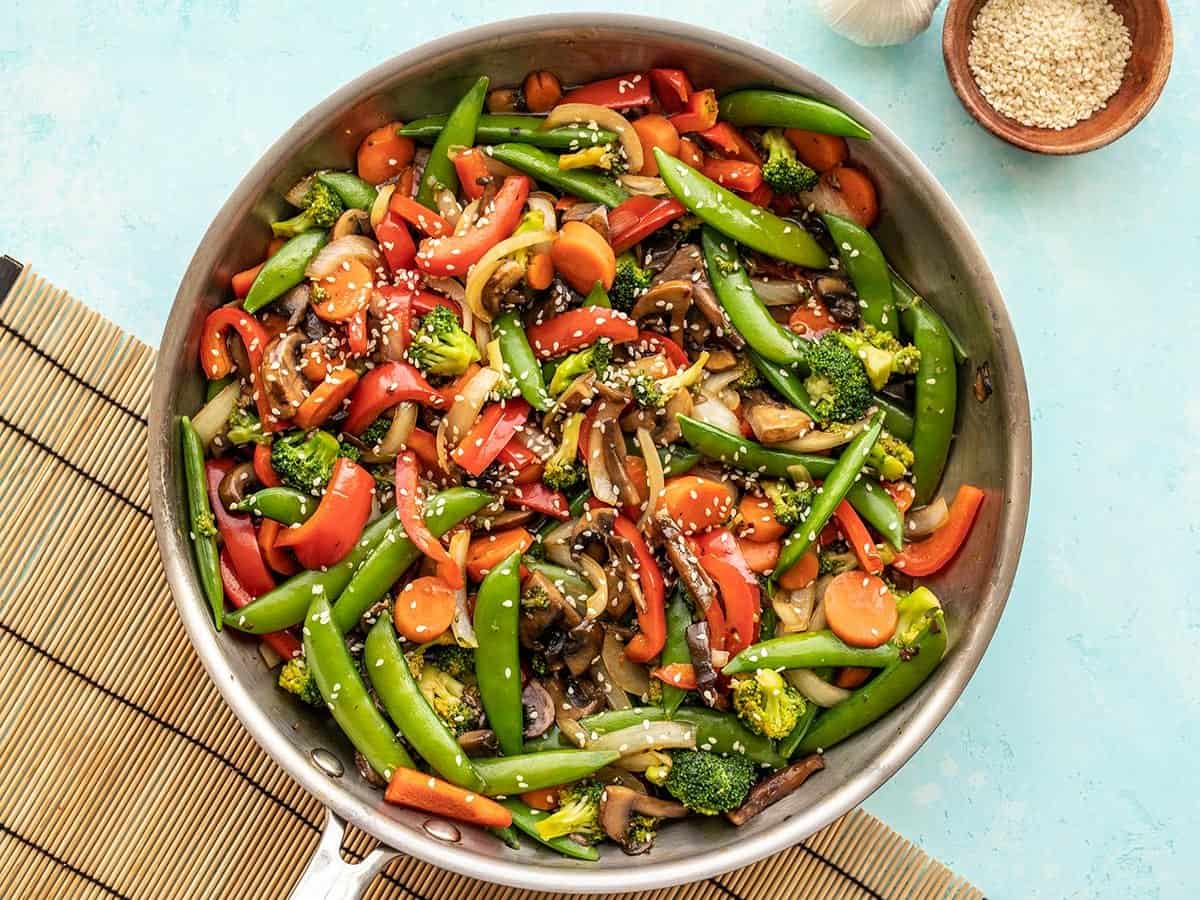In today’s fast-paced world, finding a meal that’s nutritious, quick to prepare, and satisfying can be a real challenge. Fortunately, veggie stir-fry with rice ticks all the right boxes. It’s a dish that brings together the rich diversity of vegetables, the heartiness of rice, and the bold flavors of stir-fry sauce—all while being budget-friendly and endlessly customizable.
Whether you’re a seasoned home cook or a beginner looking for healthy weekday dinner ideas, this dish is a fantastic go-to. Let’s dive into everything you need to know about creating the perfect veggie stir-fry with rice, from ingredients and preparation tips to nutritional benefits and variations.
Why Veggie Stir-Fry with Rice Is a Winner
1. Nutritious and Balanced
This dish combines complex carbohydrates from rice with the vitamins, fiber, and antioxidants of various vegetables. Stir-frying retains the vegetables’ texture and nutrients, making it a healthier cooking method compared to boiling or deep-frying.
2. Fast and Easy to Make
From start to finish, this meal can be prepared in about 30 minutes. Minimal cooking time makes it ideal for busy weeknights, and with a bit of prep work (like chopping veggies in advance), it can be even quicker.
3. Incredibly Versatile
You can use whatever vegetables you have on hand—bell peppers, carrots, broccoli, snap peas, zucchini, mushrooms, etc. The same goes for rice: white rice, brown rice, jasmine, or even cauliflower rice work perfectly.
4. Budget-Friendly
Stir-fries are a great way to use up leftover produce and pantry staples. You don’t need exotic ingredients to make it delicious. A basic soy sauce-based stir-fry sauce can go a long way.
Ingredients: The Building Blocks of Flavor
Here’s a basic version of veggie stir-fry with rice. Feel free to adapt based on personal preferences and seasonal availability.
Main Ingredients:
Rice: 1 cup of uncooked jasmine or basmati rice (or 2 cups cooked)
Vegetables:
1 bell pepper (sliced)
1 cup broccoli florets
1 medium carrot (thinly sliced)
1 zucchini (sliced)
1/2 cup snap peas
1/2 onion (sliced)
2 cloves garlic (minced)
1-inch ginger (grated)
Oil: 2 tablespoons sesame or vegetable oil
For the Stir-Fry Sauce:
3 tablespoons low-sodium soy sauce
1 tablespoon hoisin sauce (optional for sweetness)
1 tablespoon rice vinegar or lemon juice
1 teaspoon sesame oil
1 teaspoon cornstarch mixed in 2 tablespoons water (to thicken)
Toppings (Optional):
Sesame seeds
Chopped green onions
Crushed peanuts or cashews
Chili flakes or sriracha for heat
Step-by-Step Cooking Instructions
Step 1: Cook the Rice
Start by rinsing your rice thoroughly under cold water. Cook it according to package instructions. For best results, use a rice cooker or simmer on low heat with the lid on until all water is absorbed. Fluff the rice and set aside.
Step 2: Prepare the Sauce
In a small bowl, whisk together soy sauce, hoisin sauce, rice vinegar, sesame oil, and the cornstarch slurry. Set aside. This sauce will provide the signature umami flavor that ties the dish together.
Step 3: Chop the Vegetables
Cut all your vegetables into similar-sized pieces to ensure even cooking. Prepping everything before you start cooking (known as mise en place) is key to a smooth stir-fry process.
Step 4: Stir-Fry the Vegetables
Heat a wok or large skillet over medium-high heat. Add 1 tablespoon of oil and stir-fry onions, garlic, and ginger for about 1 minute until fragrant. Add carrots and broccoli first since they take longer to cook. After 2–3 minutes, toss in the remaining vegetables and stir-fry for another 3–5 minutes, until tender-crisp.
Step 5: Add the Sauce
Pour the prepared sauce over the cooked vegetables. Stir well to coat evenly. Allow the sauce to thicken slightly for about 1–2 minutes.
Step 6: Combine and Serve
Serve the hot veggie stir-fry over a bed of cooked rice. Garnish with sesame seeds, green onions, or chili flakes if desired.
Nutritional Benefits of Veggie Stir-Fry with Rice
This dish isn’t just delicious—it’s also packed with health benefits:
Fiber: The assortment of vegetables adds fiber, aiding digestion and helping regulate blood sugar levels.
Vitamins & Minerals: Ingredients like broccoli, bell peppers, and carrots are rich in vitamin C, vitamin A, potassium, and folate.
Plant-Based Goodness: A meat-free meal that can be made vegan-friendly. Great for those reducing animal products in their diet.
Low in Saturated Fat: Stir-frying with minimal oil ensures you’re not adding excessive fats or calories.
Pro Tips for the Perfect Stir-Fry
Use High Heat:
Stir-frying works best at high heat. It allows vegetables to cook quickly and retain their crisp texture.
Don’t Overcrowd the Pan:
Too many veggies at once can cause steaming instead of frying. Cook in batches if needed.
Leftovers Are Gold:
Veggie stir-fry stores well in the fridge for 3–4 days. It can also be frozen for longer storage—perfect for meal prep.
Make it Your Own:
Add Protein: Tofu, tempeh, edamame, or scrambled eggs can boost the protein content.
Change the Base: Try soba noodles or quinoa instead of rice.
Spice It Up: Add chili sauce, sriracha, or freshly sliced chilies to the sauce.
Cultural Significance and Inspiration
Stir-frying originated in Chinese cooking, where it’s known as “chao”. It’s become a global cooking method because of its speed, efficiency, and flavor-retaining qualities. While the classic Chinese stir-fry often includes meat, vegetable-only versions are equally beloved, especially in Southeast Asian and vegan/vegetarian cuisines around the world.
Incorporating rice makes the dish heartier and turns it into a complete meal. Across Asia—particularly in Thailand, China, Vietnam, and Japan—variations of stir-fried vegetables with rice are everyday staples. This global inspiration makes it both familiar and exciting no matter where you’re from.
Common Questions About Veggie Stir-Fry with Rice
Is stir-frying healthy?
Yes! When done with minimal oil and loaded with fresh vegetables, it’s one of the healthiest cooking methods. It keeps nutrients intact and avoids deep-frying’s excess fats.
Can I use frozen vegetables?
Absolutely. Frozen stir-fry blends are convenient and work well. Just make sure to thaw them slightly and drain any excess water before cooking.
What if I’m gluten-free?
Use tamari or coconut aminos instead of soy sauce for a gluten-free version.
How do I avoid soggy vegetables?
Cook at high heat and don’t overcrowd the pan. Use fresh, dry veggies and stir frequently.
Final Thoughts
Veggie stir-fry with rice is a vibrant, nourishing, and easy-to-make dish that belongs in every home cook’s repertoire. Its flexibility allows for endless creativity while still delivering on health, taste, and satisfaction.
Whether you’re cooking for yourself, your family, or guests, this dish never disappoints. Serve it fresh out of the wok with a sprinkle of sesame seeds, and you’ll see how something so simple can be so delightful.
So the next time you’re staring at a pile of leftover veggies and wondering what to do—grab your wok, cook some rice, and whip up this incredible veggie stir-fry. It might just become your new favorite meal.

